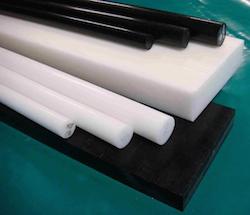Plastic materials: Acetal Plastic Fasteners
Dec 6th 2023
 Are you considering Acetal Plastic Fasteners?
Are you considering Acetal Plastic Fasteners?
Acetal plastics, otherwise known as Polyoxymethylene (POM), have particular uses, properties, advantages and disadvantages. This thermoplastic is used in high performance parts that require high durability, high stability, and low friction. Similar to most polymers, it’s composed of multiple chemical forms with slight differences in formulas and distributed in different varieties.
Acetal / Delrin Rods
Common applications for POM include high performance gear such as fasteners, minimized gear wheels, lock systems, ball bearings, and ski bindings. POM is mostly used in consumer electronics and automotive industries.
Acetal is the name generally used in the plastics industry to refer to acetal copolymer. E & T Components sells Acetal plastic fasteners, often under the Delrin tradename from DuPont.
History of Acetal Plastic Fasteners
Due to the lack of knowledge on thermal stability, acetal polymeric materials were not commercialized. Its creator, Hermann Staudinger studied the characterizations and properties of polymers and invented this structure in the 1920s.
Many other chemists began to synthesize POM, but could not grasp the concept of thermal stability. Not until Dal Nagore discovered that combining a heat resistant polymer, with acetic anhydride will convert the homopolymer, POM, to a thermally stable depolymerizable hemiacetal, processable plastic. Shortly thereafter, Nagore partnered with DuPont and replicated these parts for sale to automotive and engineering industries. Dupont created and marketed acetal as Delrin.
Properties of Acetal Plastic Fasteners
This material is known for its hardness, strength, and rigidity. The color is opaque white due to its crystalline component, but it’s available in a variety of colors. POM homopolymer has a high melting point. With a low friction, it is often susceptible to polymer degradation, which happens through contact with acidic components. Thus, this explains why it’s composed of a homopolymer and a copolymer – it resists depolymerization with this duo composition.
The copolymer is usually ethylene glycol (C2) or butanediol (C4) units, which creates cyclic ether. The O-link will no longer be an acetal component, but an ether component, which can be stable for hydrolysis. Thus, reducing chain cleavage, which could leave room for oxidative properties to breakdown the material. POM is susceptible to oxidation and is often coated with an antioxidant to prevent it from occurring.
Advantages of Acetal
- High heat resistance
- Good conductor of electricity
- Low friction coefficient
- Low water absorption
- Dielectric properties
Disadvantages of Acetal
- Subject to UV degradation
- Sensitive to non-uniform part geometry, as it may have excess shrink, warp, and voids
- Poor resistance to acids and bases
- Flammable
- Price can be average to high
- Difficult to bond
- High specific gravity
Since acetal is sensitive to oxidation and acid hydrolysis, it is also susceptible to raw acidic material and hot water. Low levels of chlorine in water supplies can cause corrosion cracking under stress. This problem is seen in the commercial and domestic American and European water supply companies’ systems. Normal moldings can endure hot temperatures, but defective ones can shed and often crack. POM copolymers and homopolymers are stabilized to endure this type of degradation. When plumbing components cracked and began to cause flooding in homes, this was the result of defective moldings in hot water supply resins. Acetal fittings fail first before the pipework, so this material isn’t used in plumbing or air components in households or industrial buildings to avoid harm to its tenants and the environment.
Uses of Acetal
Acetal is an industrialized commodity used in mechanical and electric engineering, and medical applications. It is even used in automotive components, common household items, and sports.
In biological applications, this polymer is often used in most glasswork since it can endure failure. An example would be using polymer clips on heated areas of glassware, such as distillation with a flask to column, or column to head joint. Since polymers are susceptible to acid hydrolysis and chlorine, it will have a poor performance when exposed to susceptive gases, especially hydrogen chloride. Exposure happens when the sealants wear down without warning, creating a health hazard as the glass may break or shatter. In this instance, a high quality stainless steel is the best choice to use.
Mechanical
- Sliding elements, screws, springs, nuts, chains, fan wheels, housing parts, mechanical gears, valve bodies, pump parts
- POM is tougher than ABS and cannot be painted, but it comes in different colors
Electrical
- Insulators, connectors, bobbins, and electronics such as telephones and televisions
Medical
- Medical: Metered dose inhalers (MDI), insulin pen, dental removable denture (snap on smile), and dental veneers
Automotive
- Power windows, vehicle tanks, door lock systems, light stock (including shifter for light, turn signal), articulated shells, and fuel sender units
Household Items
- Knife handles (particularly folding knives), automatic coffee brewers, watch bracelets, yo-yos, locks, hinges, handles, zippers
- Musical instruments: bagpipes, harpsichord plectra, Irish flutes, picks, tips of drum sticks, practice chanters, and tuba mouthpieces
Sports
- Paintball accessories: paintball markers such as reciprocating bolts and handles that don’t require the strength or support of aluminum
- Airsoft guns
- Long boarding to help the rider touch the road and stop, perform tricks, or slow down
Summary
When choosing components and fasteners for manufacturing and production, consider the application, the environment of the finished products and the characteristics of the materials available. Plastics, and especially some of the advanced composite materials, make a great choice for many applications and offer exceptional strength and resistance to wear.
While Acetal plastic fasteners are a fine choice for some applications, it’s not used in every application. If you have any questions on the properties of plastic fasteners or specifically about Acetal plastic fasteners and their use within your product, please do not hesitate to contact us. We’re here to help

